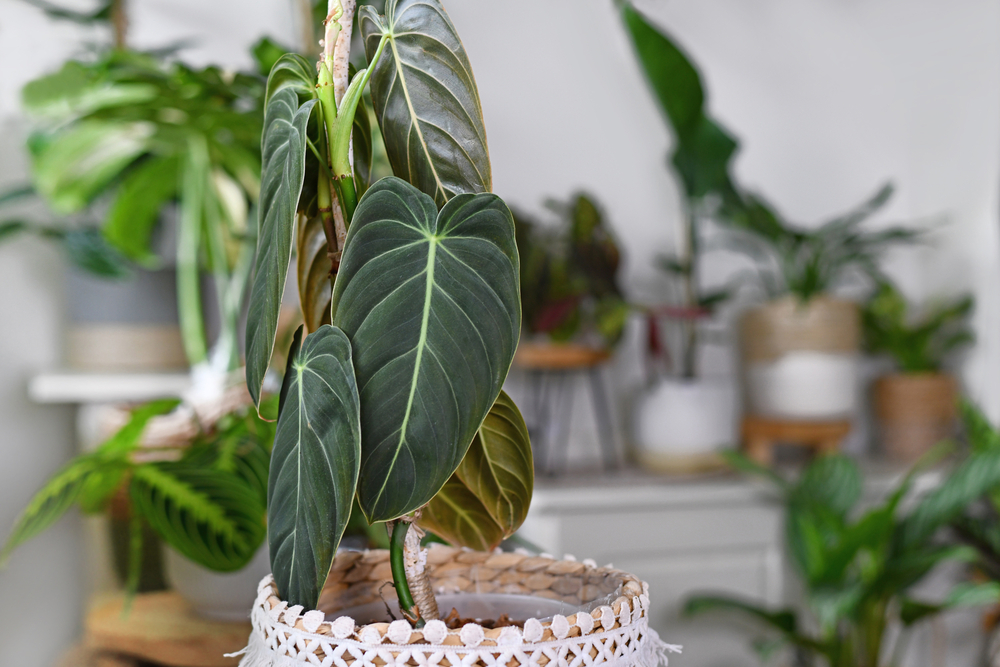AD | Featured / Affiliate Links
Imagine a lush, thriving winter garden right inside your home. Despite the cold weather outside, your indoor plants can still flourish with proper care and attention. In this blog post, we’ll share essential tips on how to keep indoor plants warm in winter, ensuring they remain vibrant and healthy all season long. So, grab a cup of hot cocoa and let’s explore the secrets to a thriving winter garden! Find more indoor plants at Prickle.
Key Takeaways
- Choose a warm spot away from cold drafts and windows to give your plants the best chance of success in winter.
- Utilise heat sources like seedling mats, LED grow lights, and space heaters for warmth & light essential for growth.
- Create mini greenhouses & adjust watering frequency while maintaining optimal humidity levels with humidifiers or misting to keep indoor/outdoor plants healthy during winter!
How to Keep Indoor Plants Warm in Winter

Choosing the Ideal Location for Your Indoor Plants
Finding the perfect location for your indoor plants during winter can make all the difference in their survival and growth. Plants need a warm and cosy environment away from cold drafts and windows to maintain their health and vitality. In the colder months, winter can be a challenging season for plants due to the extreme cold, which can freeze their cells, disrupt nutrient and water flow, and potentially lead to their demise. Moreover, indoor plants can be particularly vulnerable during winter due to draughts and central heating, which can cause the soil to freeze and thaw. This is why it’s crucial to find the ideal location for your indoor plants during winter.
Shielding your plants from cold drafts and windows prevents damage from temperature fluctuations and frost. In addition, make sure to place them in warm spots in your home, such as near fireplaces or radiators, to give your plants the best chance of success. Most houseplants thrive at temperatures between 15°C and 18°C, so finding a cozy room is essential in ensuring your potted plants stay at an optimal temperature during winter.
Avoid Cold Drafts and Windows
Cold drafts and windows can harm your indoor plants during winter by causing temperature fluctuations that may stress and damage your plants. Therefore, properly insulating your windows and positioning your plants away from cold drafts is of the utmost importance. By doing so, you can protect them from temperature fluctuations and frost damage.
Some indoor plants that require extra care when it comes to cold drafts and temperature fluctuations are:
- ZZ Plant
- Moth Orchid
- Clivia
- Jade
- Snake Plant
- Christmas Cactus
- Ponytail Palm
- Philodendron
Keep this in mind when choosing a location for your indoor plants during cold weather. Ensuring your plants are protected from cold drafts and windows can help them thrive even in the coldest months.

Utilise Warm Spots in Your Home
Strategically positioning indoor plants, including pot plants, around houseplants warm spots in your home can remarkably enhance their growth and health during winter. Although houseplants should be kept away from heat sources like radiators, log burners, or fires, choosing a suitable warm spot helps maintain their optimal temperature range, facilitating growth and flourishing, even in the colder months.
The perfect temperature for most indoor plants during winter is between 60°F and 75°F (15°C and 24°C). By positioning your plants near warm spots in your home, you can maintain consistent temperatures that will help your indoor plants thrive in winter. Remember that plants are sensitive to their environment, and the extra effort to find the perfect warm spot will pay off in the form of beautiful, healthy plants during the colder months.
Insulating Plant Pots and Containers
Insulating plant pots and containers is a transformative strategy for preserving the warmth of your indoor plants during winter. This method of protecting the roots from cold temperatures guarantees the health and vitality of your plants. There are several creative ways to insulate plant pots and containers during winter, such as wrapping pots or plants with fabric, using insulating pot materials like bubble wrap, or burying plastic pots into beds to draw warmth from deeper soil.
Aluminum foil is another useful material for keeping your indoor plants warm during winter. By wrapping aluminum foil around or under plant pots, you can reflect sunlight and keep the area warmer for longer, providing your plants with the warmth they need. Experiment with different insulating materials and techniques to find the best solution for your indoor plants during the winter months.

Elevate Plants Off the Floor
Placing indoor plants above the floor is a critical measure to safeguard their health and growth during winter. It helps protect their roots from sudden temperature changes and potential damage by keeping them away from the cold ground. There are various materials and methods you can use to stylishly elevate your plants off the floor, such as:
- Metal stands
- Wooden plant stands
- Plant dollies or caddies with wheels
- Sustainable materials
It is recommended to use pot feet or bricks to elevate plants off the floor and keep them away from cold surfaces for optimal growth. Elevating your plants not only protects them from the cold but also adds an aesthetic touch to your indoor garden, creating a visually appealing space for you and your plants to enjoy.
Use Proper Pot Materials
Selecting appropriate pot materials plays a key role in preserving the warmth of your indoor plants during winter. Insulation materials like fabric grow bags or bubble wrap around pots offer an additional layer of protection, aiding in the prevention of frost damage and maintenance of plant health.
Bubble wrap is an effective and cost-efficient way to insulate your plant pots during winter. The air-filled pockets in the bubble wrap act as a barrier against cold temperatures, protecting your plants from the harsh winter elements.
To insulate your plant pots with bubble wrap:
- Secure a double layer of bubble wrap around the pot.
- Use string or twine to secure the bubble wrap in place.
- Make sure the bubble wrap covers the entire pot, including the bottom.
- Trim any excess bubble wrap.
By following these steps, you can ensure that your plants warm in winter stay warm and insulated throughout the winter months.

Employing Heat Sources for Indoor Plants
Besides securing an ideal location and insulating your plant pots, utilizing heat sources can effectively sustain optimal temperatures for your indoor plants during winter. Seedling heat mats, LED grow lights, and space heaters are all great options to provide the warmth and comfort your plants need to thrive during the colder months.
Each heat source has its unique benefits and drawbacks, so it’s essential to choose the one that best suits your indoor garden’s needs. For example:
- Seedling heat mats are excellent for providing gentle, consistent warmth directly to the root area of your plants.
- LED grow lights offer nighttime warmth and essential light for photosynthesis.
- Space heaters can quickly warm an entire room but can be costly and should be used with caution.
By employing the right heat source for your indoor plants, you can ensure their health and growth during winter.
The Benefits of Seedling Heat Mats
Seedling heat mats are a fantastic tool for keeping your indoor plants warm during winter. These thin, flexible panels provide just the right amount of heat to help your seeds and cuttings get off to a great start, offering gentle, steady warmth to your indoor plants. By using a seedling heat mat, you can foster healthy root growth and ensure the overall well-being of your plants during the colder months.
Heat mats are particularly useful for germinating seeds and propagating cuttings, as they provide warmth to the root area, allowing them to grow as if it were springtime. Investing in a high-quality heat mat can quickly heat the root area by 50-77°F (10-25°C) above the ambient air temperature within 2 minutes, offering a warm growth environment for your plants and encouraging better germination and growth.

LED Grow Lights for Nighttime Warmth
LED grow lights are another excellent option for providing nighttime warmth and essential light for photosynthesis, ensuring your indoor plants stay healthy and vibrant during winter. These energy-efficient lights offer the perfect balance of warmth and light, making them an ideal choice for indoor gardens, especially when natural light is limited.
In addition to providing nighttime warmth, LED grow lights can powerfully contribute to the success of indoor plants during winter by offering the essential light spectrum for photosynthesis, fostering vigorous growth and development. They generate less heat compared to other types of grow lights, making them perfect for indoor use without burning the plants.
By using LED grow lights, you can help ensure optimal growing conditions for your indoor plants during the winter months.
Space Heaters: A Direct but Costly Solution
Space heaters can effectively warm indoor plants during winter, but they can be costly to run and should be used with caution. A typical space heater consumes a whopping 1,500 watts of electricity, making them an expensive option for maintaining your indoor plants’ warmth. However, when used correctly, space heaters can provide the necessary heat for your indoor plants to thrive during winter.
To ensure the safe use of a space heater for indoor plants, follow these tips:
- Maintain a safe distance between the heater and the plants.
- Avoid sudden temperature changes by gradually adjusting the heater.
- Utilise a convection space heater, which provides gentle and even heat distribution.
- Insulate the plant pots to help retain heat.
- Monitor the temperature regularly and adjust the heater accordingly for optimal results.
While space heaters can be a direct but costly solution, they can help your indoor plants thrive during the cold winter months.

Creating a Mini Greenhouse Environment
Establishing a mini greenhouse environment provides a stellar solution for retaining warmth and humidity for indoor plants during winter. Grow tents or plastic domes can be used to create a cosy mini greenhouse environment for your indoor plants during the winter season, providing a warm and humid space that protects them from cold drafts and temperature fluctuations.
By creating a mini greenhouse environment, you can enjoy the benefits of warmth from the sun while safeguarding your plants from wind, rain, and frost. This method not only keeps your indoor plants warm but also helps them thrive in the challenging winter conditions. Consider investing in a grow tent or plastic dome to give your indoor plants the best possible environment during winter.
Winter Watering and Humidity Management
Adjusting watering and humidity levels to suit your indoor plants’ needs during winter is crucial for their health and growth. As plants enter a state of dormancy during the colder months, they require less water due to slower growth rates and lower evaporation rates. Being mindful of these changes and adjusting your watering schedule accordingly can help your indoor plants thrive during winter.
It’s essential to monitor the moisture level of the soil and water only when it is dry, as overwatering can lead to root rot and other issues. In addition to adjusting your watering schedule, it’s crucial to maintain optimal humidity levels for your indoor plants during winter. By using humidifiers or misting your plants regularly, you can keep the air around them moist and protect their foliage from dry air damage.

Reduce Watering Frequency
Reducing watering frequency for indoor plants during winter is essential for their health and well-being. Due to shorter days and lower light levels, indoor plants enter a state of dormancy and require less water. It’s important to keep this in mind when adjusting your watering schedule, as overwatering can lead to problems such as root rot and fungal infections.
To ensure your indoor plants stay healthy during winter, follow these tips:
- Water them once every 10-21 days, depending on their specific needs.
- Check the soil moisture before watering and ensure it’s dry at least 2 inches deep before adding water.
- By reducing watering frequency and monitoring soil moisture, you can help your indoor plants thrive during the challenging winter months.
Maintain Optimal Humidity Levels
Maintaining optimal humidity levels for indoor plants during winter can be the key to their survival. As indoor heating systems can cause the air to become dry, it’s essential to ensure that your plants receive the proper humidity levels they need to thrive.
By using a humidifier or misting your plants regularly, you can maintain optimal humidity levels for your indoor plants during winter, protecting their foliage from dry air damage. It’s also important to:
- Group your plants together
- Place them on top of gravel trays filled with water
- Consider using a terrarium to increase humidity levels in your indoor garden.
By maintaining optimal humidity levels, you can ensure your indoor plants stay healthy and vibrant throughout the winter season.

Caring for Outdoor Plants During Winter
Outdoor plants likewise necessitate attentive care during winter for assured survival and growth. Protecting them from frost, insulating their roots, and providing proper shelter from harsh weather conditions are all essential steps to ensure your outdoor plants thrive during winter.
Some options to keep your outdoor plants warm and protected during winter are:
- Grow boxes
- Cold frames
- Applying mulch on top of the soil up to the rims of the pots
- Wrapping outdoor containers in bubble wrap or horticultural fleece
By taking these steps to protect plants, you can ensure the health and well-being of your outdoor plants, effectively keeping plants thriving throughout the winter season.
Summary
In conclusion, keeping your indoor plants warm during winter is essential for their health and growth. By choosing the ideal location, insulating plant pots and containers, employing heat sources, creating a mini greenhouse environment, and managing watering and humidity levels, you can ensure your indoor and outdoor plants thrive during the cold winter months. With these essential tips, your winter garden will be a warm, inviting oasis for both you and your plants to enjoy.

Frequently Asked Questions
How can I keep my plants warm in a cold house?
Cover your plants with old sheets and blankets, bubble wrap or aluminum foil, and wrap pots or plants with fabric. Heat mats can also be used to keep indoor plants warm as the weather gets colder.
How can I protect my indoor plants from cold drafts and windows during winter?
Protect your indoor plants from cold drafts and windows by keeping them away from these sources, using proper insulation for windows, and placing them in warm spots in your home.
How can LED grow lights help my indoor plants during winter?
LED grow lights can keep your indoor plants healthy and vibrant during the winter by providing nighttime warmth and essential light for photosynthesis.
How often should I water my indoor plants during winter?
In winter, water your indoor plants every 10-21 days, depending on their specific needs. Make sure the soil is dry at least 2 inches deep before watering.
What can I do to maintain optimal humidity levels for my indoor plants during winter?
Stay on top of humidity levels this winter by using a humidifier or misting your plants regularly. Grouping them together, placing them over water-filled trays, and creating a terrarium are also great ways to boost humidity.
Image Credit: depositphotos.com





























